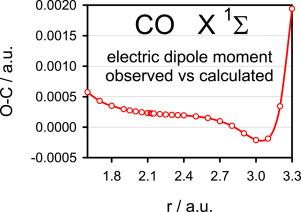从头算方法预测一氧化碳电偶极矩函数的准确性
IF 1.9
3区 物理与天体物理
Q2 OPTICS
Journal of Quantitative Spectroscopy & Radiative Transfer
Pub Date : 2025-09-16
DOI:10.1016/j.jqsrt.2025.109673
引用次数: 0
摘要
CO分子在其基电子态X1Σ+下的精确电偶极矩函数已经使用单参考耦合簇方法确定,达到CCSDTQP近似水平,结合增强核价相关一致基集,aug-cc-pCVnZ,达到八元zeta质量。将从头计算的预测函数与实验推导的预测函数进行了比较。讨论了应用理论方法的准确性。本文章由计算机程序翻译,如有差异,请以英文原文为准。

On the accuracy of ab initio methods in predicting the electric dipole moment function of carbon monoxide
Accurate electric dipole moment function of the CO molecule in its ground electronic state has been determined using the single-reference coupled-cluster approach, up to the CCSDTQP level of approximation, in conjunction with the augmented core-valence correlation-consistent basis sets, aug-cc-pCVZ, up to octuple-zeta quality. The ab initio predicted function is compared with its experimentally-derived counterparts. The accuracy of applied theoretical methods is discussed.
求助全文
通过发布文献求助,成功后即可免费获取论文全文。
去求助
来源期刊
CiteScore
5.30
自引率
21.70%
发文量
273
审稿时长
58 days
期刊介绍:
Papers with the following subject areas are suitable for publication in the Journal of Quantitative Spectroscopy and Radiative Transfer:
- Theoretical and experimental aspects of the spectra of atoms, molecules, ions, and plasmas.
- Spectral lineshape studies including models and computational algorithms.
- Atmospheric spectroscopy.
- Theoretical and experimental aspects of light scattering.
- Application of light scattering in particle characterization and remote sensing.
- Application of light scattering in biological sciences and medicine.
- Radiative transfer in absorbing, emitting, and scattering media.
- Radiative transfer in stochastic media.

 求助内容:
求助内容: 应助结果提醒方式:
应助结果提醒方式:


